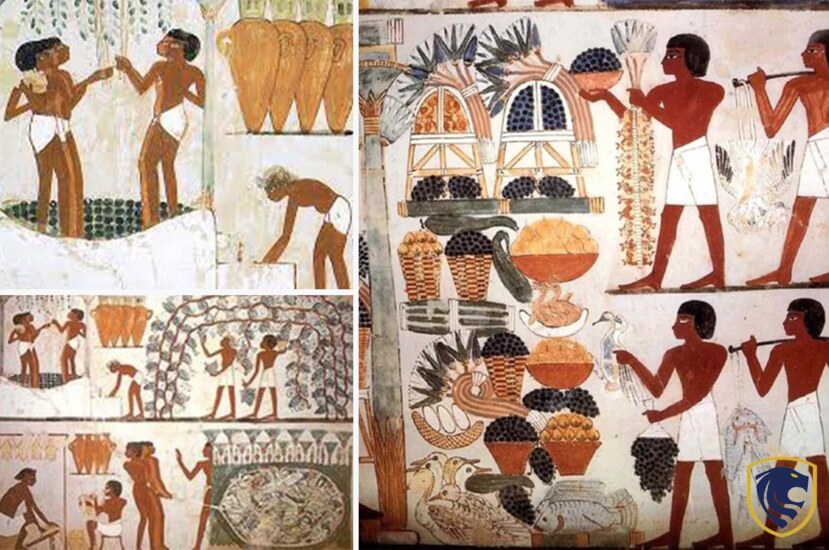Ancient civilizations faced the challenge of preserving food without the modern conveniences we enjoy today. They developed ingenious methods to extend the shelf life of perishable items, ensuring a stable food supply throughout the year. Also, these ancient techniques, born out of necessity, offer a fascinating glimpse into the resourcefulness and ingenuity of our ancestors. From drying and smoking to fermenting and pickling, the ancient methods of food preservation have stood the test of time. Moreover, by understanding and appreciating these age-old techniques, we can gain insights into the rich culinary traditions and cultural practices of the past. Join us on a journey through history as we explore the fascinating world of ancient food preservation methods and discover how our ancestors preserved their food for survival.
Kishmish panj
The ancient method of preserving grapes in Afghanistan is a remarkable tradition. It has allowed farmers to enjoy fresh, juicy grapes throughout the winter months. Known as “Kishmish panj” or “Grapes of Five,” this method has been practiced for centuries. Also, it continues to be a vital part of Afghan agriculture.
The process begins with carefully selecting the best grapes from the harvest. These grapes are then laid out in the open air on specially prepared straw mats. The grapes are left to dry naturally under the sun for several days, allowing the moisture in the grapes to evaporate. This drying process concentrates the sugars in the grapes, resulting in a sweet and flavorful taste.

Kishmish panj; Ancient Methods Of Food Preservation
Once the grapes have dried to the desired level, they are gathered and arranged in small clusters, traditionally numbering five grapes per cluster. The clusters are then wrapped in layers of paper or newspaper, forming tight bundles that resemble small packages.
These grape bundles are stored in cool, dark spaces such as cellars or underground chambers. The unique microclimate of these storage spaces, combined with the paper wrapping, helps to regulate temperature and humidity. This can prevent the grapes from spoiling. The bundles are carefully stacked, ensuring proper air circulation to maintain freshness.
How did they prevent the spreading of the decay?
Throughout the winter, the grape bundles are regularly checked and any spoiled grapes are removed to prevent the spread of decay. The remaining grapes continue to retain their moisture and flavors, maintaining their quality for several months.
This ancient preservation method not only allows Afghans to enjoy fresh grapes during the winter. But also serves as a valuable source of income for farmers. The preserved grapes, known as “kishmish,” are highly sought after and are sold in local markets. Furthermore, it is exported to neighboring countries.

How did they prevent the spreading of the decay?
The practice of preserving grapes in this manner has become an integral part of Afghan culture and culinary traditions. It represents the ingenuity and resourcefulness of the Afghan people in harnessing nature’s bounty and ensuring food security during the winter months.
In a world where modern preservation techniques have become dominant, the ancient method of preserving grapes in Afghanistan stands as a testament to the wisdom and resilience of traditional agricultural practices. It serves as a reminder of the rich cultural heritage and deep connection between the Afghan people and their land.
Burying in the ground
The ancient method of burying food in the ground for preservation is a fascinating technique that has been practiced by various cultures throughout history. This method takes advantage of the natural properties of the earth to create a cool and controlled environment for storing food. The technique has been documented in different parts of the world and has left behind historical evidence of its effectiveness.

Burying in the Ground; Ancient Methods Of Food Preservation
Evidence From History
One notable example of this preservation method is found in traditional Inuit culture. The Inuit people of the Arctic region would dig shallow pits in the permafrost, the permanently frozen ground. These pits served as natural refrigerators, allowing the Inuit to store meat and fish for extended periods. The low temperatures of the permafrost helped to keep the food frozen, preventing spoilage and microbial growth. Archaeological excavations have revealed these underground storage pits, providing evidence of the practice.
Another historical evidence of the burying-in-the-ground method comes from ancient China. During the Han Dynasty (206 BCE-220 CE), large underground storage chambers called “yug” were constructed. These chambers were used to store grains, fruits, and vegetables. The guy provided a cool and dark environment that protected the food from heat, sunlight, and pests. Excavations of these yug sites have uncovered well-preserved food items, such as millet, wheat, and beans, showcasing the effectiveness of this ancient preservation technique.

Burying in the ground
In addition to these examples, there are accounts of Native American tribes in North America utilizing underground storage pits known as “cache pits” or “potato cellars” to preserve food. These pits were lined with grass, leaves, or bark and filled with food items like potatoes, corn, and dried meat. So, the insulating properties of the earth helped maintain a stable temperature and humidity. Also, it keeps the food fresh for longer periods.
Ash preservation
The ancient method of food preservation using ash is a remarkable technique that has been employed by diverse cultures throughout history. Ash preservation involves coating or burying food items in wood ash, which acts as a natural preservative due to its alkaline properties. This method has left behind historical evidence of its utilization in various parts of the world.

Ash Preservation; Ancient Methods Of Food Preservation
Evidence From History
One prominent example of ash preservation can be found in traditional Native American cultures. Native American tribes, such as the Hopi and Navajo, would use wood ash as a means to preserve corn. They would bury corn ears in pits lined with ash, creating an alkaline environment that helped prevent spoilage and deter pests. Furthermore, archaeological excavations have uncovered these pits and the preserved corn within them, providing tangible evidence of the ancient practice.
Ancient Egypt also offers insight into the use of ash preservation. The Egyptians, renowned for their advanced preservation techniques, utilized ash in the mummification process as well as in preserving food. They would coat fruits, vegetables, and meat with a mixture of salt and ash, known as natron, to desiccate and protect the items from decomposition. The well-preserved mummies and food remnants discovered in Egyptian tombs serve as evidence of the efficacy of ash preservation in their culture.

Ash preservation
In Asia, specifically in Japan, ash preservation was employed for centuries to preserve fish. The technique, known as “niboshi,” involved layering dried fish with wood ash to extend its shelf life. The alkaline nature of the ash helped inhibit bacterial growth and maintain the quality of the fish. Historic records and traditional practices in Japan validate the long-standing use of ash preservation in the region.
The ancient method of ash preservation showcases the resourcefulness and practicality of ancient civilizations in ensuring food preservation. Also, the historical evidence found in archaeological sites and cultural practices provides a glimpse into the ingenuity of our ancestors and their efforts to prolong the shelf life of perishable foods using readily available materials.




